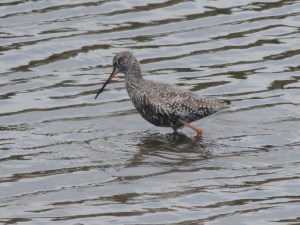According to the excellent Aves de Portugal website and the Tourist Information Birdwatching guide the Tringa Erythropus are common in the Formosa estuary. However it was months before we spotted these shy birds, and even when we did we only saw one. We did though see him in the same spot on more than one day.
Their English name is Spotted Redshank and their Portuguese Perna-vermelha-escuro.  They are migratory birds passing through Portugal from north Europe on their way to warmer climates, some though do spend the winter months in Europe. In their breeding plumage they are unmistakable, this one is almost in full summer.
They are migratory birds passing through Portugal from north Europe on their way to warmer climates, some though do spend the winter months in Europe. In their breeding plumage they are unmistakable, this one is almost in full summer.
Now if a bird has the word ‘spotted’ in its name there must be another one out there without spots!  In this case the other one is called the Common Redshank (tringa tatanus) or Perma-vermelha (Red Legs) in Portuguese. They are much lighter in colour and their beaks have more red. They are also very common in the Ria Formosa, and at times very irritating to birders. As like the Black-Winged Stilts the Common Redshanks have a tendency to create a huge amount of noise as you approach warning every other bird there are humans about. They were once known as ‘yelpers of the marsh’, a great nickname as it accurately describes their loud (and irritating) warning call.
In this case the other one is called the Common Redshank (tringa tatanus) or Perma-vermelha (Red Legs) in Portuguese. They are much lighter in colour and their beaks have more red. They are also very common in the Ria Formosa, and at times very irritating to birders. As like the Black-Winged Stilts the Common Redshanks have a tendency to create a huge amount of noise as you approach warning every other bird there are humans about. They were once known as ‘yelpers of the marsh’, a great nickname as it accurately describes their loud (and irritating) warning call.
The Redshanks are not the only shanks in the Ria Formosa. There is also the Common Greenshank (tringa nebularia). It is the largest of all the birds in this family, and as their Portuguese name, Perna-verde, suggests their legs are green. They are also much paler in colour. It is usually a solitary bird we see, feeding alongside other waders such as Plovers, Godwits, Redshanks and Sandpipers. I think that is some type of plover with the Greenshank below, but I couldn’t tell you which genus! And I’ve included a Common Sandpiper in the final gallery. The sandpiper looks almost the same size as the Greenshank in my photographs, and even the Redshanks look a similar size. They are not!
It would seem I make the same mistake with my bird photographs as I do with my flower ones, I aim for great close-ups. Absolutely fine when you know what you are looking at but if you are uncertain like I am most of the time then you need the wider angles for identification purposes so you can determine size.
Despite my struggles to identify the waders, I do enjoy birding. As not only does it keep the cogs whirring and provide endless photographic opportunities, it has enabled me today to perfect a six word title for Cate’s ‘Six Word Saturday‘.













OMG!!! That is my name! My name is Tringa Beqiri and according to my research about “Tringa”, are extremely rare! Is this true? 🙂🙂
Btw: Hope you had a Merry Christmas, a good year and i wish you the best if this year, 2017! 🙂🙂🙂🙂🙂🙂🙂🙂🙂🙂🙂🙂🙂🙂🙂🙂🙂🙂🙂🙂🙂🙂🙂🙂🙂🙂
Tringa Beqiri Xoxo <3
Oh how amazing is that!
Not sure they are extremely rare but are certainly not common. They are a very elegant bird and wonderful to observe ☺
Ok.
Are you one of those people that learn about birds and search for them?
Not quite! We’re birders rather than twitchers……the latter drive hundreds of miles to see one bird, whereas we’re happy seeing the same birds again and again 😊
Feliz Ano Novo 😃
Ok! thank you! I have read your blog its amazing!! Your blogs are WAAAYyy better than mine!
Oh Tringa thank you so so much….such a lovely thing to say. Am sure your blog is going to be amazing too as your first few posts are so heartwarming and honest. Take care and do stay in touch
I will! 🙂
Love a ‘shy bird’ :). And the way they step so daintily. You never skimp on the details, Becky. Hope you’re having a good weekend.
Good weekend thanks, especially when the sun decided to be less shy today.
Great shots, greatly enjoyed by this poet stuck in Crowville
Thanks Ron . . . . should I worry about you being stuck or is it a temporary condition?!
I love it when people get specific about birds! I saw the photos and thought ‘sandpiper’, but when I googled it, I realized how sloppy that definition was. Lovely photos.
Thank you so much . . . . and yes there are a variety of ‘sandpipers’ so it can get confusing. You were not far off though as the Green Sandpiper is also a Tringa!
Birding is something I do as an afterthought, usually when I am on my way somewhere. Neverthless, it is enjoyable to see a bird that seems to be elusive.
With my other half it can never be an afterthought on our travels!!
What lovely photos and birds! Thank you for all the wonderful info too. I actually learned something.
Thank you so much for your lovely comments, and am delighted you found it informative 😀